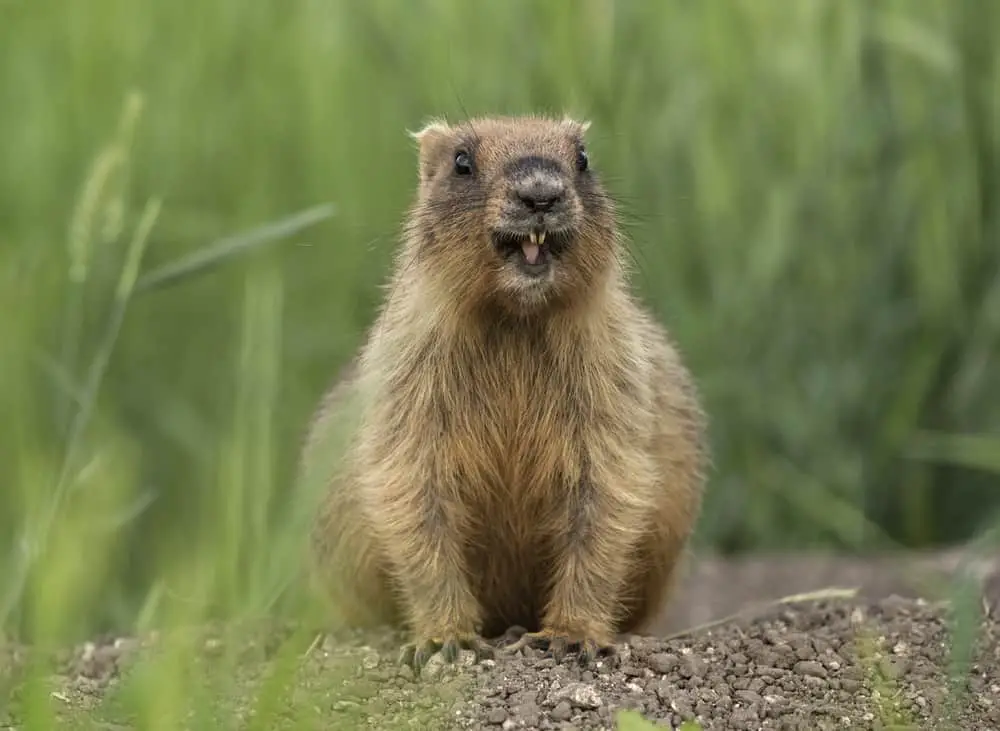
Animal: Groundhog
Other Common Names: Woodchuck
Type of Animal: Mammal
Family: Squirrel (Scuiridae)
Distribution: Groundhogs are found in North America, from Canada to the southern regions of the United States.
Habitat: Woodlands, open forests, fields, and some rocky slopes.
Diet: Herbivores; eat plants, insects, and snails on occasion.
Longevity: Approximately 3 years
Adult Weight: 5 to 13 pounds (2 to 6 kilograms)
Adult Body Length: 16 to 20 inches (41 to 51 centimeters)
Behaviors: They are active during the day making them a diurnal species. Groundhogs burrow into the dirt to create multi-chambered burrows to store food, rest, and hibernate. They only live with a mate and tend to be solo otherwise.
Table of Contents
- Gopher
- Prairie Dog
- Badger
- Beaver
- Muskrat
- Marmot
- Ground Squirrel
- Hyrax
- Nutria
- Chipmunk
- Mole
- Vole
- Marten
- Hedgehog
- Wombat
Gopher
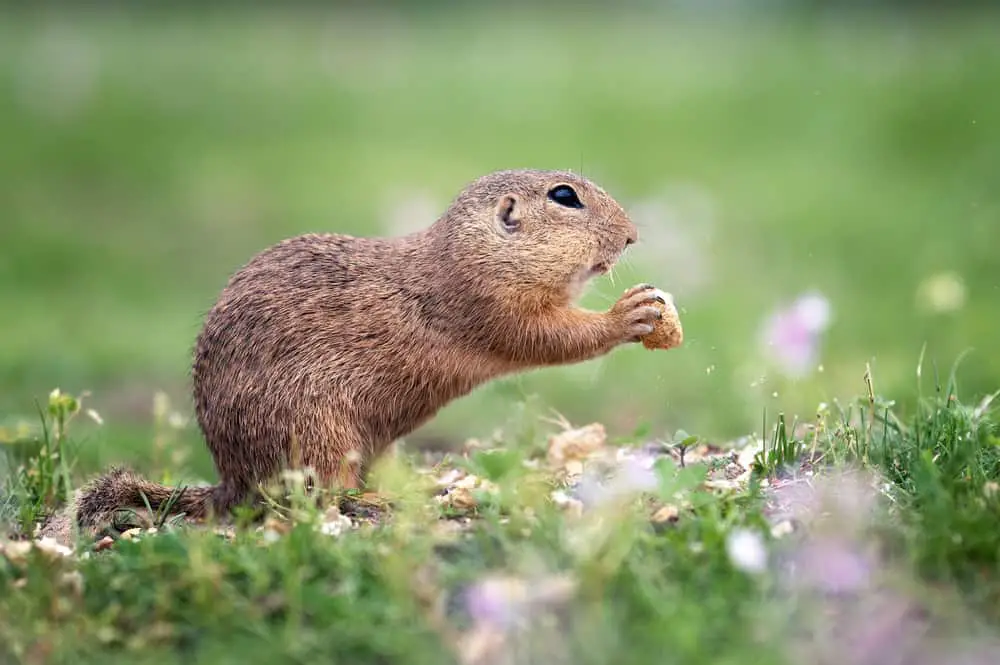
Animal: Gopher
Type of Animal: Mammal
Family: Pocket Gopher (Geomyidae)
Distribution: Gophers live throughout North and Central America, mostly in regions of the United States and Mexico.
Habitat: Woodlands, grass prairies, coastal areas, and mountainous regions.
Diet: Omnivores; eat earthworms, other bugs, shrubs, plant roots, and some vegetables.
Longevity: Approximately 4 years
Adult Weight: Around 0.5 pounds (200 grams)
Adult Body Length: 6 to 8 inches (15 to 20 centimeters)
Behaviors: These animals are active during the day and tend to remain in underground burrows for most of their lives, making them fossorial individuals. Gophers usually live alone unless with their mate.
Similarities to Groundhogs: Both of these animals burrow underground and live isolated from one another.
Differences to Groundhogs: Gophers have fur-less tails, long teeth that have a yellow to brown coloration, fur-lined cheeks for storing food, and are smaller. Groundhogs have fur-covered tails, white incisors, and a relatively large body mass.
Prairie Dog
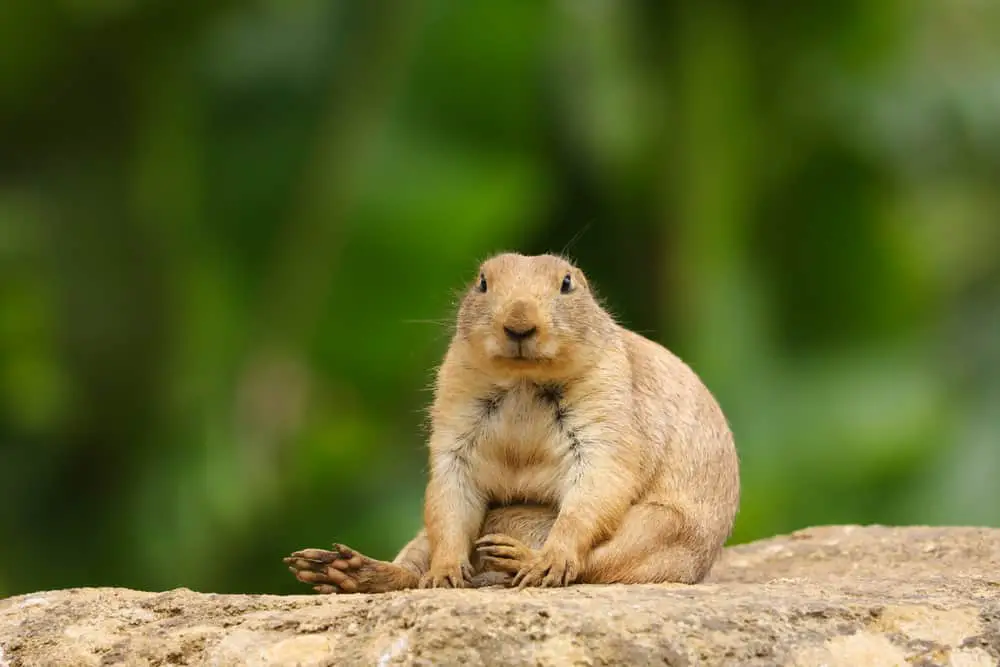
Animal: Prairie Dog
Type of Animal: Mammal
Family: Squirrel (Scuiridae)
Distribution: This is a North American species living in areas of Canada, the United States, and Mexico.
Habitat: Primarily dry and sparsely vegetated grasslands, but also low valleys, mountain meadows, and prairies.
Diet: Omnivores; eat insects, the leaves of flowering plants, seeds, roots, weeds, and grasses.
Longevity: Approximately 3 to 5 years
Adult Weight: 2 to 3 pounds (0.9 to 1.3 kilograms)
Adult Body Length: 11 to 12 inches (28 to 30 inches)
Behaviors: Active during the day when it is sunny, these animals are very social and live in groups called coteries where one male guards over a small group of females.
Similarities to Groundhogs: Both belonging to the Squirrel family, these animals have a similar body shape. They also share the behavior of living underground in complex tunnels.
Differences to Groundhogs: They have fur-less tails, long teeth that have a yellow to brown coloration, fur-lined cheeks for storing food, and are smaller which contrasts the groundhog.
Badger

Animal: Badger
Type of Animal: Mammal
Family: Weasel (Mustelidae)
Distribution: Badgers live in regions of North America, Europe, and Great Britain.
Habitat: Found from meadows in the higher alpine elevations, to sea level, primarily in grasslands, deserts, and semi-deserts.
Diet: Omnivores; eat earthworms, insects, fish, reptiles, birds, small mammals such as rodents, and ground squirrels.
Longevity: Around 24 years
Adult Weight: 4 to 35 pounds (2 to 16 kilograms)
Adult Body Length: Around 2 feet (24 inches)
Behaviors: Active more during the evening hours, these animals also go into a state of torpor, which is a temporary 24-hour state of hibernation. They are also solitary and will take on enemies twice their size.
Similarities to Groundhogs: Both these animals have a similar body structure with a short, fur-covered tail.
Differences to Groundhogs: Badgers are identified by the bold markings on their face. These animals are also twice the size of a groundhog.
Beaver
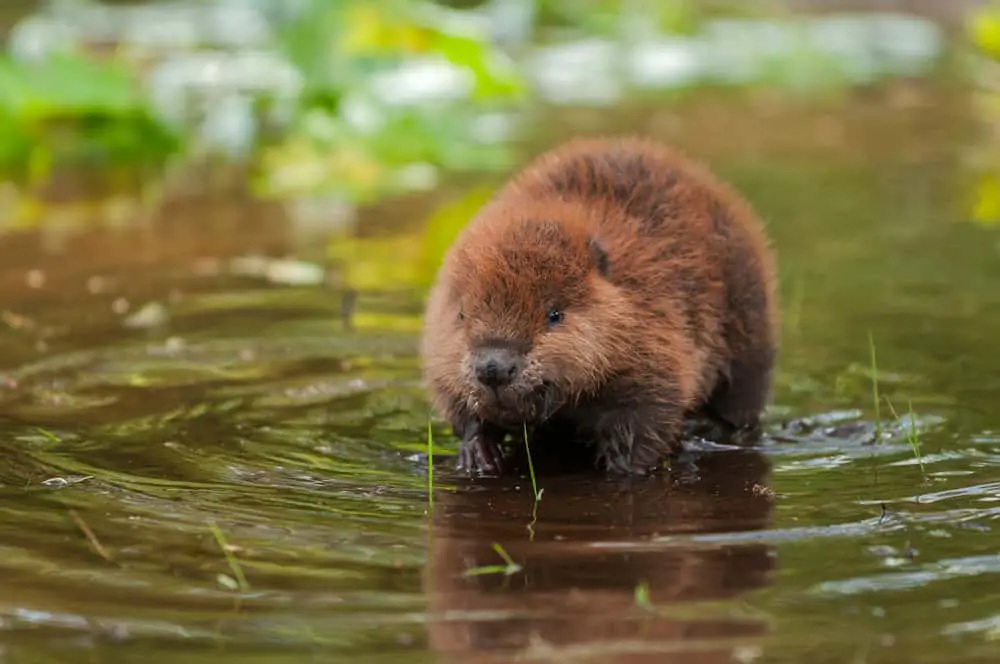
Animal: Beaver
Type of Animal: Mammal
Family: Beaver (Castoridae)
Distribution: Throughout North America and regions of Europe.
Habitat: Ponds, lakes, rivers, streams, and wetlands.
Diet: Herbivorous; eat vegetative matter such as grass, ferns, roots, stems, twigs, and bark.
Longevity: 10 to 15 years.
Adult Weight: 24 to 71 pounds (10 to 32 kilograms)
Adult Body Length: Around 2.5 feet (30 inches)
Behaviors: They live in groups of families and are active mainly during the night. Beavers can be territorial towards animals outside of their colony.
Similarities to Groundhogs: The front teeth of groundhogs and beavers are constantly growing, and thus need to be trimmed down routinely by gnawing on plant material.
Differences to Groundhogs: Other than having a flat, large tail, beavers have yellow front teeth. Groundhogs sport short tails and white teeth.
Muskrat
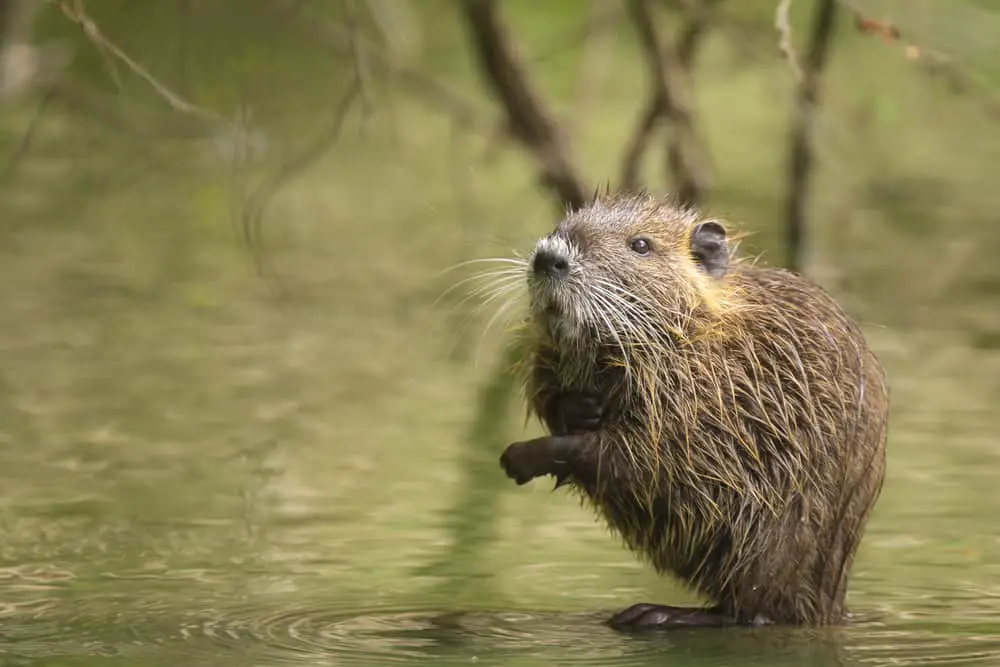
Animal: Muskrat
Type of Animal: Mammal
Family: Cricetid Rodents (Cricetidae)
Distribution: Europe, Terra del Fuego, North America, and regions of Asia.
Habitat: swamps, drainage canals, marsh, lakes, ponds, and rivers.
Diet: Omnivores; eats amphibians, shellfish, and fish. Aquatic vegetation makes up most of its diet.
Longevity: About 4 years.
Adult Weight: 1 to 5 pounds (0.4 to 2 kilograms)
Adult Body Length: 16 to 28 inches (40 to 71 centimeters)
Behaviors: Active mostly during the night, muskrats live with one mate and fight off anyone outside of their family.
Similarities to Groundhogs: Both of these animals share a dark brown to reddish coloration in their fur and live with their mate.
Differences to Groundhogs: Muskrats have yellow front teeth as opposed to the white teeth of a groundhog. They also have thick, long tails.
Marmot
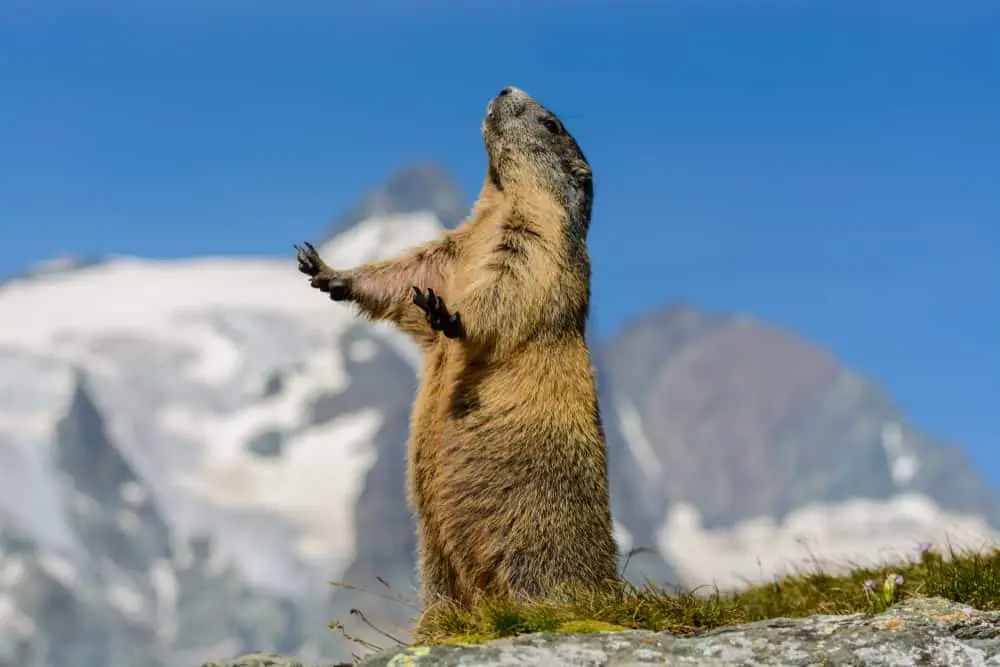
Animal: Marmot
Type of Animal: Mammal
Family: Squirrel (Sciuridae)
Distribution: North America, Asia, and Europe.
Habitat: Plains, mountains, montane meadows, tundra, and the forest.
Diet: Vegetarian; eat mostly grass, blossoms, plants, and leaves.
Longevity: Around 15 years.
Adult Weight: From 5 to 15 pounds (2 to 7 kilograms)
Adult Body Length: Around 2 feet (24 inches)
Behaviors: Day dwellers, making them diurnal, the marmot hibernates, climb trees when need be, and live in large groups.
Similarities to Groundhogs: In the same family, these are both active during the day and have a similar body shape.
Differences to Groundhogs: Marmots tend to have yellow speckling along with their bodies with white edges around their eyes while groundhogs tend to be more red than yellow.
Ground Squirrel
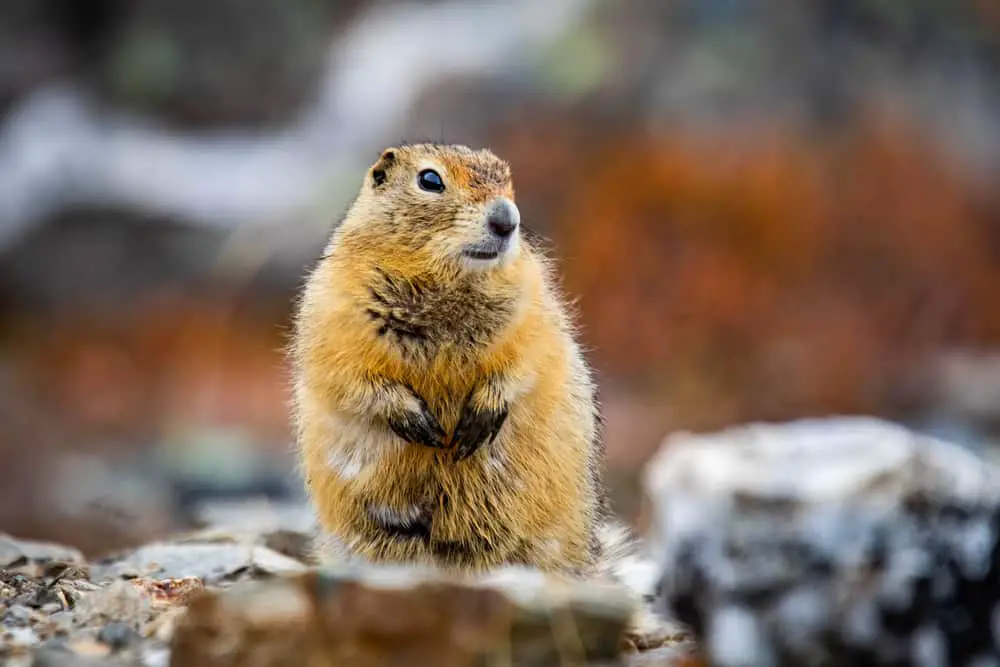
Animal: Ground Squirrel
Type of Animal: Mammal
Family: Squirrel (Sciuridae)
Distribution: North America, Asia, Europe, and Africa.
Habitat: Plains, meadows, hillsides, granite taluses, and pastures.
Diet: Herbivore; Diet changes seasonally but they typically eat plants, seeds, and nuts.
Longevity: 3 to 10 years.
Adult Weight: Around 1.3 pounds (0.5 kilograms)
Adult Body Length: Around 8 inches (20 inches)
Behaviors: Diurnal, or day, dwellers that live in colonies, though they do not socialize with one another.
Similarities to Groundhogs: Their coloration and foraging behaviors and diet are both very similar.
Differences to Groundhogs: Ground squirrels are about half the size and have a long, bottlebrush tail.
Hyrax
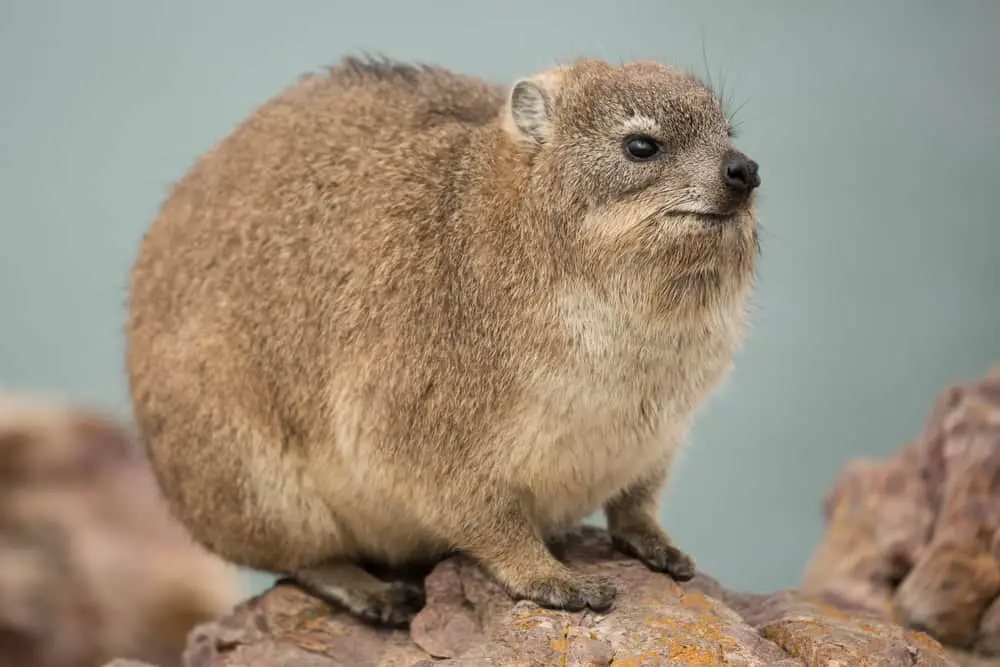
Animal: Hyrax
Type of Animal: Mammal
Family: Hyrax (Procaviidae)
Distribution: Africa and the Middle East.
Habitat: They typically are found in dry savannas, dense rainforests, and Afro-alpine moorlands.
Diet: Omnivores; eat grasses, fruit, leaves, insects, small lizards, and the eggs of birds.
Longevity: Approximately 8 years
Adult Weight: Around 6 pounds (3 kilograms)
Adult Body Length: About 20 inches (50 centimeters)
Behaviors: Diurnal species within colonies, so that they can have one member keep watch while the others eat.
Similarities to Groundhogs: Both belonging to the Squirrel family, these animals have a similar body shape. They also share having a shorter tail.
Differences to Groundhogs: Half the mass of a groundhog, the hyrax lives in a sizeable colony.
Nutria
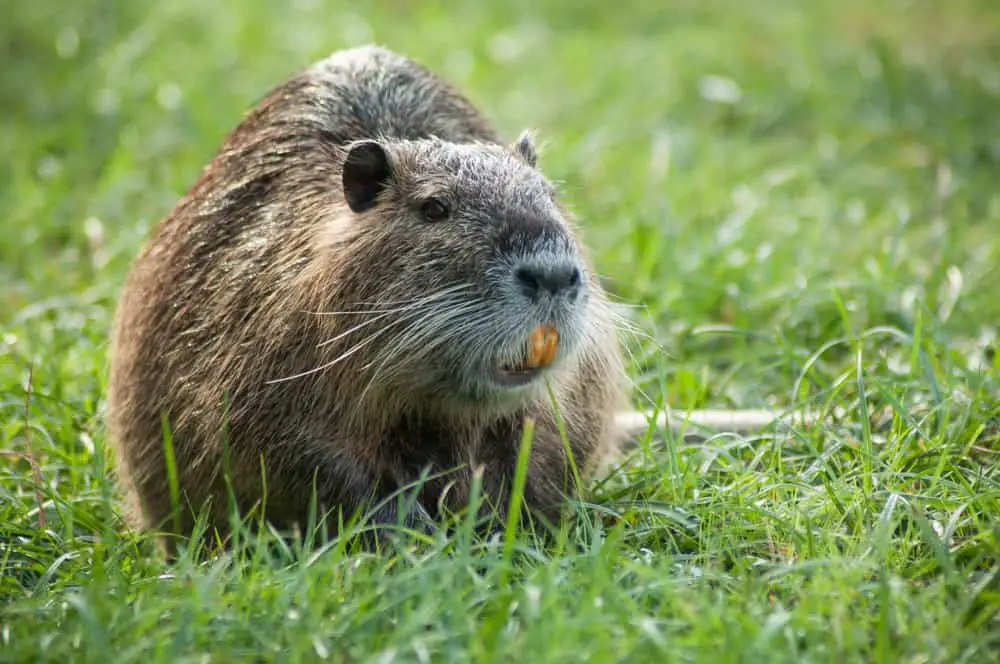
Animal: Nutria
Type of Animal: Mammal
Family: Nutria (Myocastoridae)
Distribution: Native to South America, they have spread to North America, Africa, Asia, and Europe.
Habitat: Rivers, lakes, wetlands, canals, and streams.
Diet: Herbivores; eats mostly aquatic plants, including the roots, shrubs, and grasses.
Longevity: About 6.5 years.
Adult Weight: 14 pounds (6 kilograms)
Adult Body Length: 2 feet (24 inches)
Behaviors: Mostly active during the night, these animals burrow just under the water in social groups of about ten individuals.
Similarities to Groundhogs: Sometimes being similar in size, the groundhog has similar coloration to the Nutria.
Differences to Groundhogs: The Nutria is a mostly aquatic rodent, while the groundhog is strictly terrestrial. They also have orange teeth, whereas the groundhog has white incisors.
Chipmunk
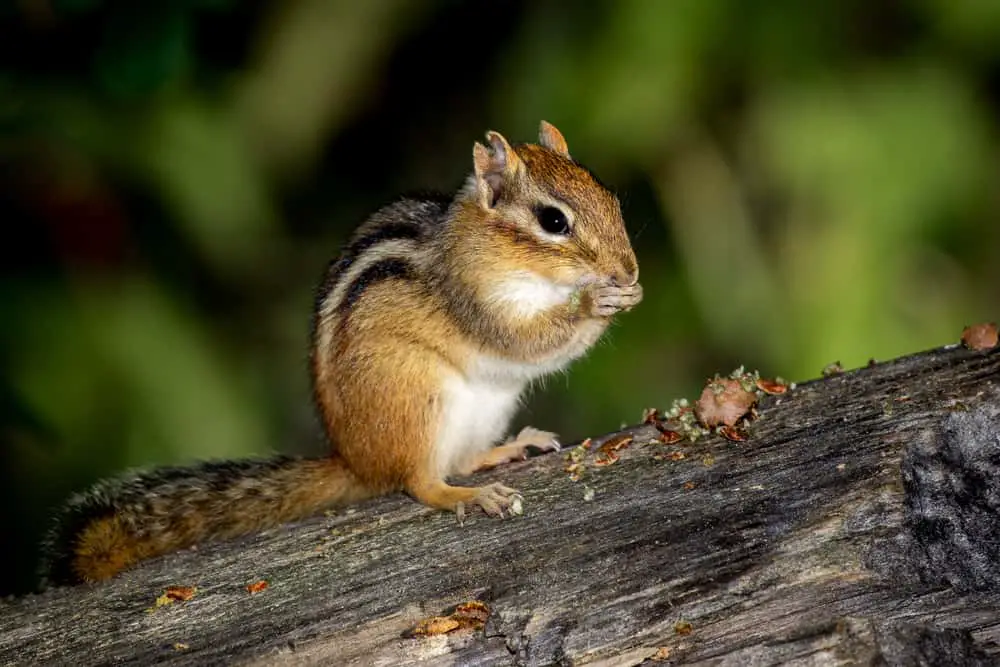
Animal: Chipmunk
Type of Animal: Mammal
Family: Squirrel (Sciuridae)
Distribution: Most species of chipmunk are found in North America, except for the Siberian chipmunk, which is located in Asia.
Habitat: Plains, mountains, deserts, and forests.
Diet: Omnivores; eats insects, fruit, grain, seeds, nuts, and berries, which they store within cheek pouches.
Longevity: 3 years for the North American species; Siberian chipmunk lives 6 to 10 years.
Adult Weight: about 1.5 to 5 ounces (42 to 141 grams)
Adult Body Length: 4 inches (10 centimeters) for the North American species and 8 inches (20 centimeters) for the Siberian chipmunk.
Behaviors: These animals are active during the day and are solitary. The colder months are when they will retreat to their burrows to hibernate.
Similarities to Groundhogs: Groundhogs have similar behavior. Both of these animals are solitary and retreat to complex underground burrows that they dig themselves.
Differences to Groundhogs: Chipmunks are considerably smaller than groundhogs. They also can store food within their cheek pouches, which the groundhog does not have.
Mole
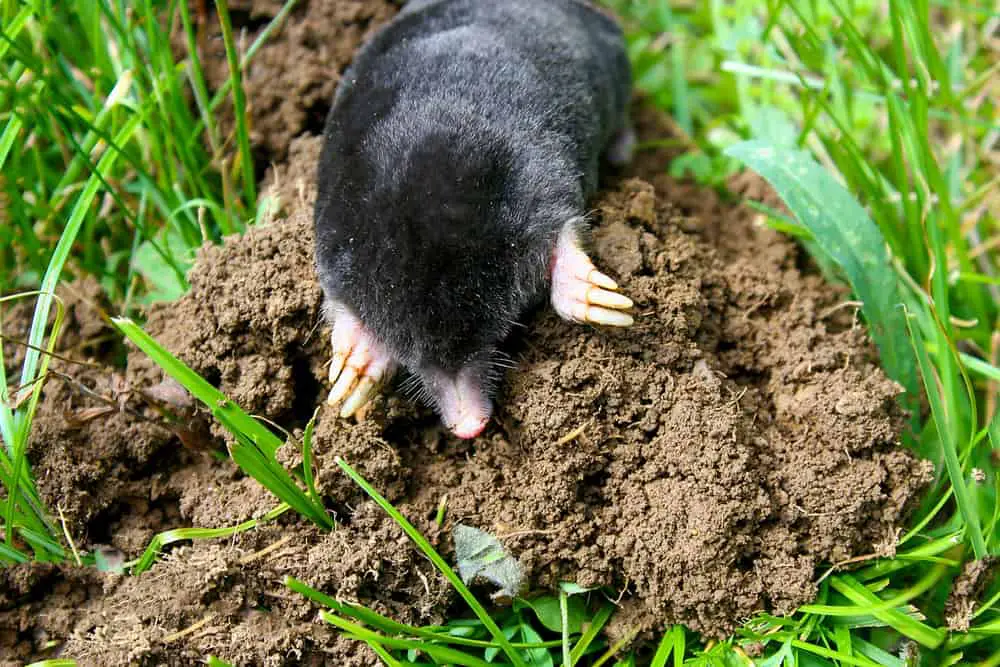
Animal: Mole
Type of Animal: Mammal
Family: True Moles (Talpidae)
Distribution: live on every continent aside from South America and Antarctica, and they do not occupy Ireland.
Habitat: Grasslands, grasslands, dunes, woodlands, urban areas, and gardens.
Diet: Mostly insectivorous with some herbivorous tendencies. The majority of their diet contains slugs, insects, worms, and snails. They do occasionally feed on seeds when need be.
Longevity: 6 years.
Adult Weight: 0.5 to 5 ounces (14 to 141 grams)
Adult Body Length: 3 to 8 inches (7 to 20 inches)
Behaviors: These solitary animals spend the vast majority of their time within the expansive tunnels that they dig, all in pursuit of food. There are a few species that do live in small colonies.
Similarities to Groundhogs: Moles tend to be solitary animals, like the groundhog. They also both rely heavily on maintaining their underground tunnels to survive.
Differences to Groundhogs: Moles are considerably smaller than groundhogs and do not have prominent eyes on their head.
Vole
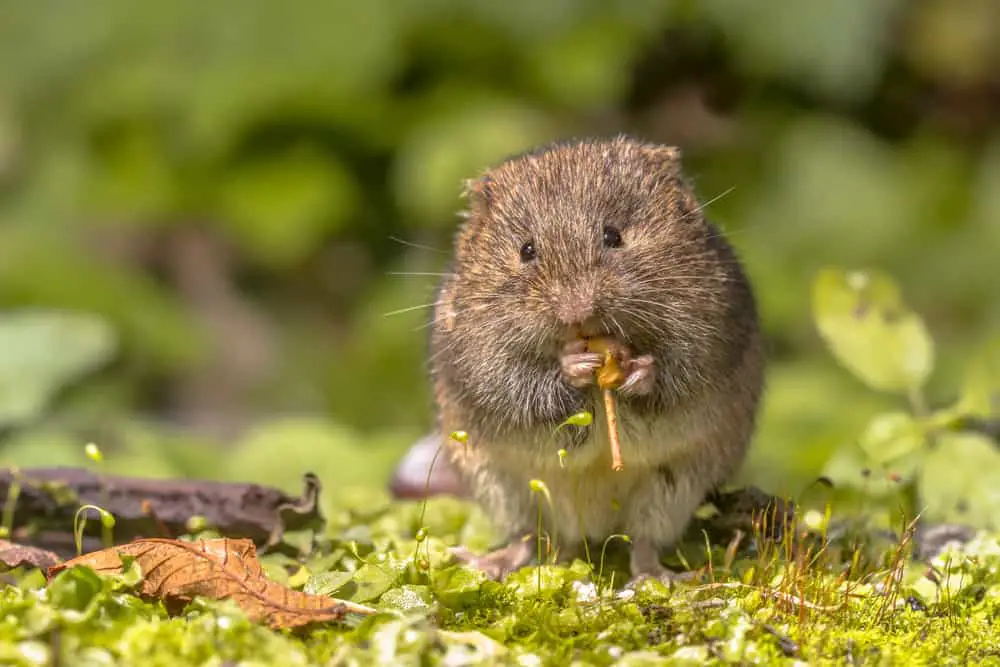
Animal: Vole
Type of Animal: Mammal
Family: Cricetid Rodents (Cricetidae)
Distribution: Found in Northern America from Alaska down to the mountains of Mexico, and regions of southern China, Japan, and Taiwan.
Habitat: Herbivores; eat a variety of grasses, seeds, plant matter, and bark when their usual food source isn’t readily available.
Diet: Herbivores; eats mostly aquatic plants, including the roots, shrubs, and grasses.
Longevity: 3 to 6 months
Adult Weight: Around 1 ounce (28 grams)
Adult Body Length: 4 to 6 inches (10 to 15 centimeters)
Behaviors: These animals are active during both the day and night. They do not hibernate and live in colonies with the adults and young.
Similarities to Groundhogs: Voles share the characteristic of having white front incisors, just as the groundhog has.
Differences to Groundhogs: Voles are much smaller than groundhogs, and are social animals, whereas groundhogs do not like to live in groups.
Marten
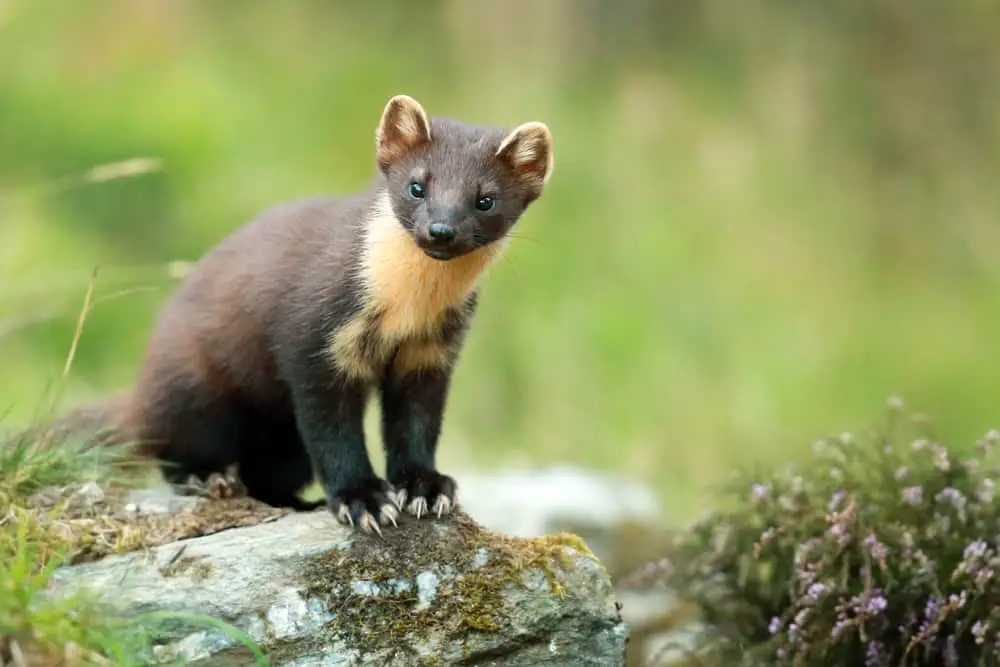
Animal: Marten
Type of Animal: Mammal
Family: Weasel (Mustelidae)
Distribution: Found mainly in northern North America, Canada, Europe, and Great Britain.
Habitat: Their favorite dwelling spots are forests that are coniferous or mixed-wood. As long as they have trees to hide in, they can thrive quite easily.
Diet: Omnivores; their diet ranges from squirrels, rodents, birds, insects, nuts, fruit, and carrion, which are dead animals left from a different animal.
Longevity: About 15 years
Adult Weight: 1 to 13 pounds (28 to 368 grams)
Adult Body Length: 17 to 28 inches (43 to 71 centimeters)
Behaviors: These animals usually roam in the night hours and hunt during dawn and dusk. They tend to be solitary unless roaming around with a mate. Although they hunt on the forest floor, they spend most of their time in trees.
Similarities to Groundhogs: They both would rather be solitary, though can be seen with a mate during certain times of the year.
Differences to Groundhogs: Martens have long bodies, which is the opposite of the stocky groundhog. Groundhogs are also strictly terrestrial, unlike the tree-dwelling Marten.
Hedgehog
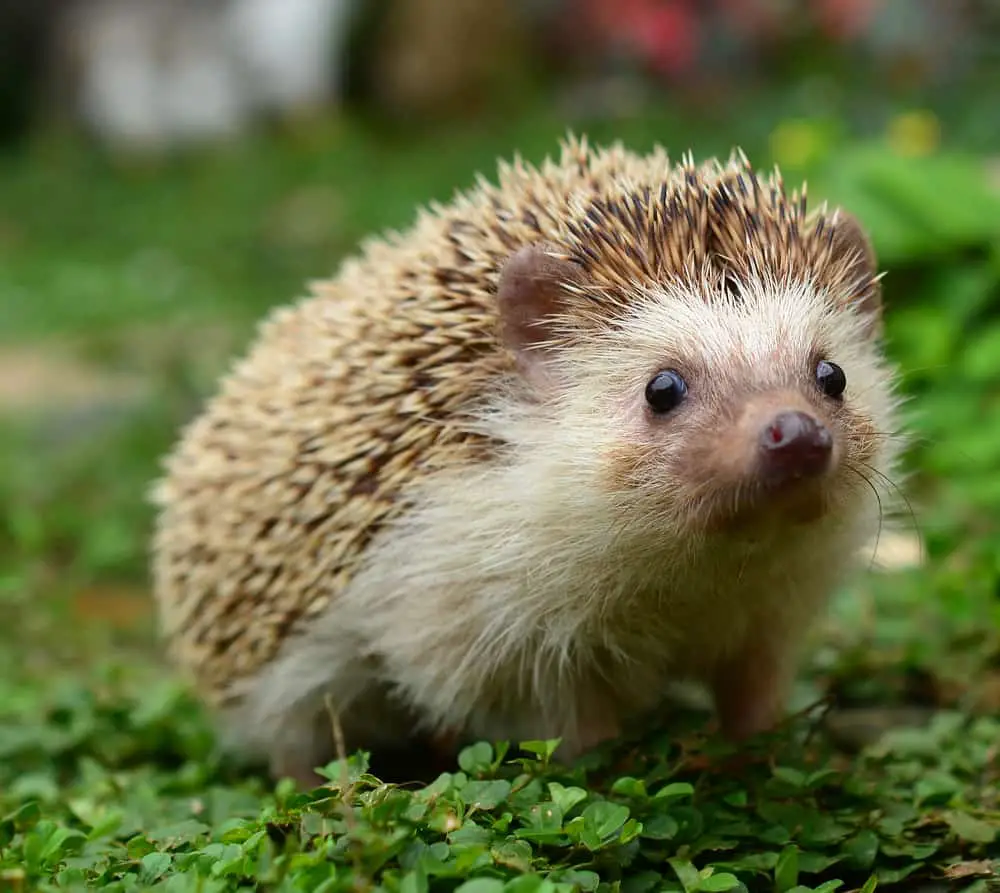
Animal: Hedgehog
Type of Animal: Mammal
Family: Hedgehog (Erinaceinae)
Distribution: Species within this family are located in regions of Asia, Africa, New Zealand, and Europe.
Habitat: Hedgehogs are relatively adaptable, being able to survive in savannas, forests, scrublands, deserts, and gardens.
Diet: Insectivores; consume several insects such as the caterpillar, beetle, earwig, and millipedes. They also eat worms and slugs.
Longevity: About 2 to 3 years
Adult Weight: 1 to 3 pounds (28 to 85 grams)
Adult Body Length: 5 to 12 inches (12 to 30 centimeters)
Behaviors: The Hedgehog is a solitary animal that becomes active during the night, though this is seasonal. Some species hunt at dusk during the warmer months.
Similarities to Groundhogs: These animals live solitary lives and are terrestrial. The groundhog has similar coloration to the groundhog as well.
Differences to Groundhogs: The most visible difference is that hedgehogs have stiffened hair, or spines, lining their back. They also do not dig underground to survive.
Wombat
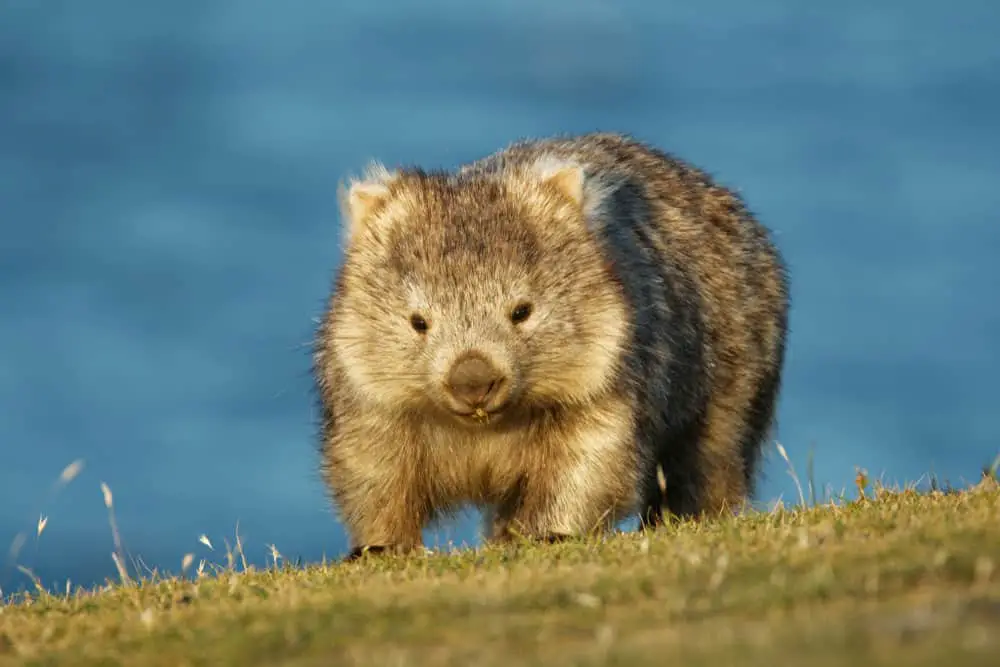
Animal: Wombat
Type of Animal: Mammal
Family: Wombat (Vombatidae)
Distribution: Wombats are only found in Australia, specifically in the southern portion of Queensland and the northern areas of New South Wales.
Habitat: Depending on the species, wombats dwell in partial forests along coastal regions, western slopes, or the open country.
Diet: Herbivores; eat vegetation, specifically in the form of grasses, roots, bark, and herbs.
Longevity: 15 years
Adult Weight: 44 to 77 pounds (19 to 35 kilograms)
Adult Body Length: 40 to 45 inches (102 to 114 centimeters)
Behaviors: Wombats are nocturnal animals that dig out their burrows, which can be up to 30 meters in length with a depth of a few meters. They live solitary lives unless for a short time with a mate.
Similarities to Groundhogs: Both the groundhog and wombat are skilled at digging underground tunnels with their front claws. They also share a similar body shape and herbivorous feeding
Differences to Groundhogs: The fur lining of a wombat is rather dull compared to the reddish-brown that some groundhogs take on. Wombats also come out at night, where groundhogs are diurnal.
